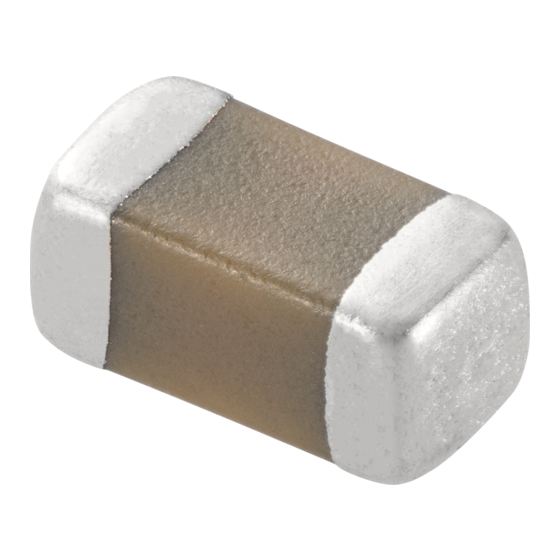
Table of Contents
Advertisement
Quick Links
Chip Monolithic Ceramic Capacitor for General
GRM188R60J226MEA0_ (0603, X5R:EIA, 22uF, DC6.3V)
_: packaging code
1.Scope
This product specification is applied to Chip Monolithic Ceramic Capacitor used for General Electronic equipment.
2.MURATA Part NO. System
(Ex.)
GRM
18
(1)L/W
Dimensions
3. Type & Dimensions
(1)-1 L
(1)-2 W
1.6±0.2
0.8±0.2
4.Rated value
(3) Temperature Characteristics
(Public STD Code):X5R(EIA)
Temp. coeff
or Cap. Change
-15 to 15 %
5.Package
mark
(8) Packaging
f180mm Reel
D
PAPER W8P4
f330mm Reel
J
PAPER W8P4
Product specifications in this catalog are as of Mar.5,2016,and are subject to change or obsolescence without notice.
Please consult the approval sheet before ordering.
Please read rating and !Cautions first.
GRM188R60J226MEA0-01
8
R6
(2)T
(3)Temperature
Characteristics
Dimensions
(2) T
e
0.8±0.2
0.2 to 0.55
(4)
Rated
Temp. Range
Voltage
(Ref.Temp.)
-55 to 85 °C
DC 6.3 V
(25 °C)
Packaging Unit
4000 pcs./Reel
10000 pcs./Reel
0J
226
(4)Rated
(6)Capacitance
(5)Nominal
Voltage
Tolerance
Capacitance
(Unit:mm)
g
0.6 min.
Specifications and Test
(6)
(5) Nominal
Capacitance
Capacitance
Tolerance
22 uF
±20 %
1
Reference Sheet
M
EA0
D
(7)Murata's
(8)Packaging
Control Code
Code
Methods
(Operating
Temp. Range)
-55 to 85 °C
Advertisement
Table of Contents

Summarization of Contents
Capacitor Rating and Characteristics
Operating Temperature Limits
Defines operational temperature limits and self-heating considerations for capacitor selection.
Atmosphere Restrictions
Details environmental restrictions and potential impacts from gases and liquids on capacitor performance.
Piezoelectric Effect in Capacitors
Explains vibration and noise generation in high dielectric constant capacitors due to the piezoelectric effect.
Assembly and Mounting Procedures
Mounting Other Components
Guidelines for mounting components on the back side of the board after capacitor installation.
Inserting Leaded Components
Precautions for inserting leaded components to prevent board bending and capacitor cracking.
Socket Attachment and Removal
Work planning to prevent board bending when attaching or removing sockets.
Secure Fastening Procedures
Preventing board bending and over-tightening when securing components with screws.
Soldering and Mounting Guidelines
PCB Design for Component Reliability
Notice for pattern forms and considerations for chip cracking to ensure component reliability.
Board Design for Soldering
Adhesive Application Guidelines
Guidelines for adhesive amount and viscosity for secure chip mounting during soldering.
Adhesive Coverage Specifications
Specifies minimum adhesive coverage for different chip sizes to ensure bonding strength.
Adhesive Curing Process
Importance of proper curing for chip adhesion and insulation resistance against moisture.
Flux Usage for Flow Soldering
Recommendations for flux usage, type, and concentration in flow soldering processes.


Need help?
Do you have a question about the GRM188R60J226MEA0D and is the answer not in the manual?
Questions and answers